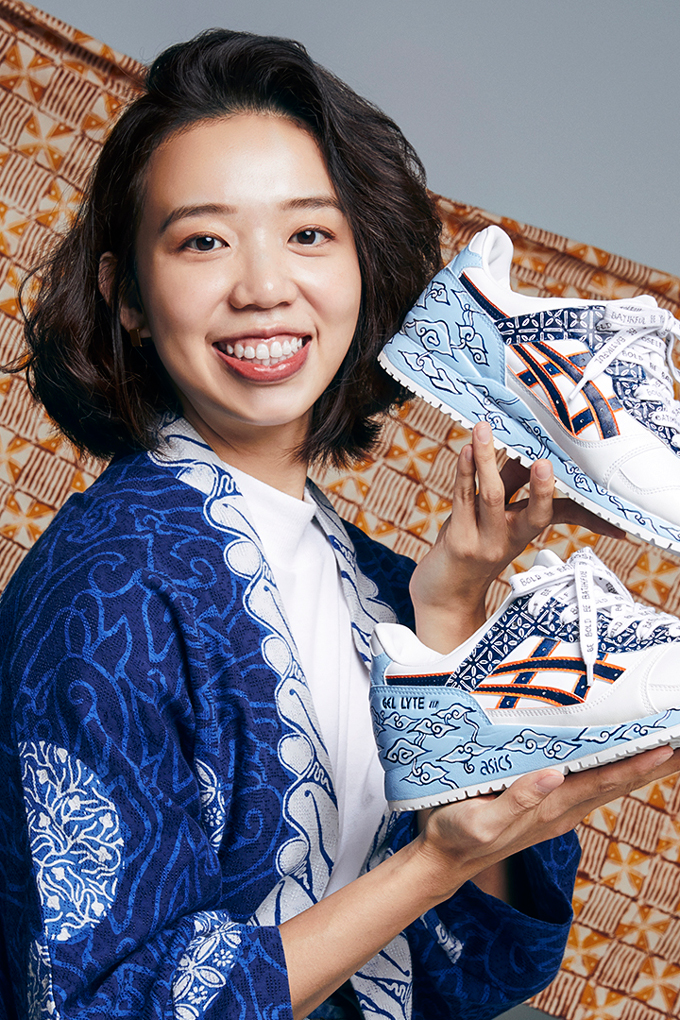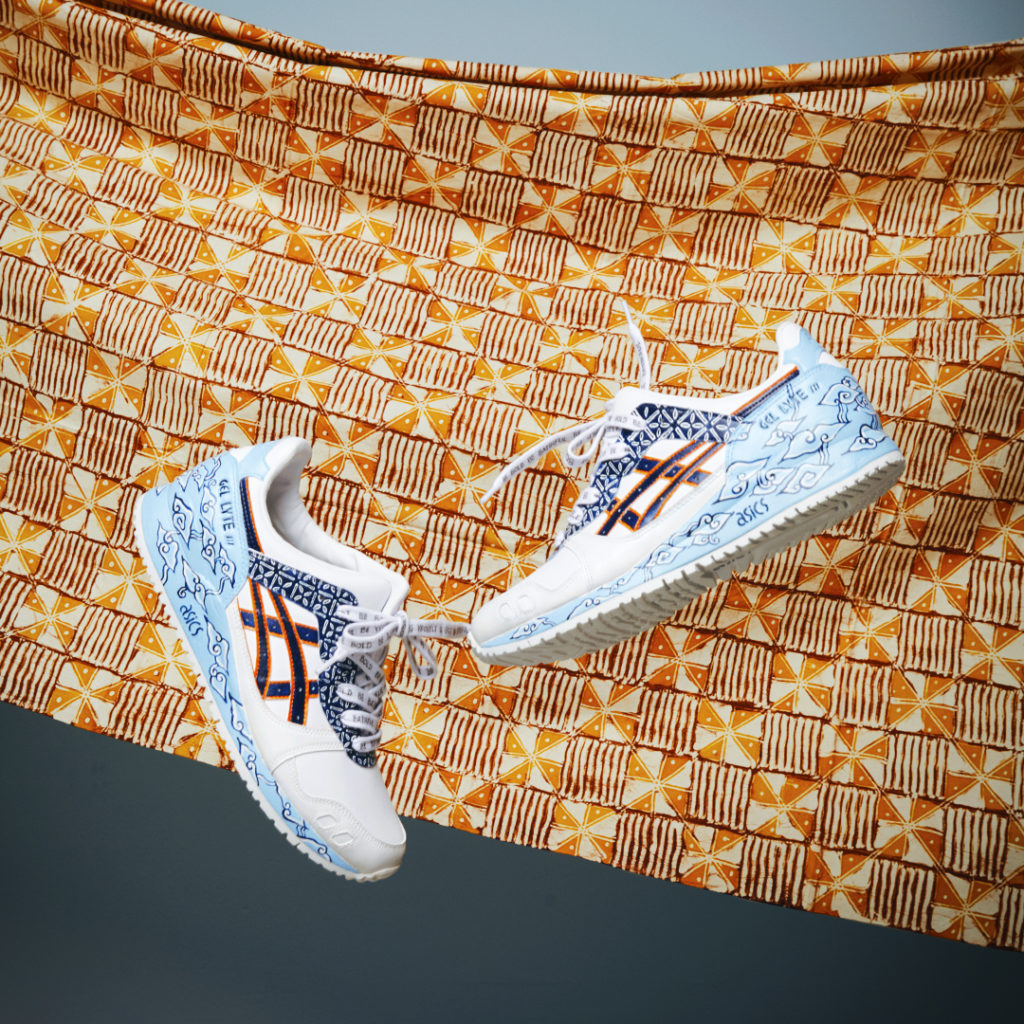When Desleen Yeo first started her batik-only brand, YeoMama Batik in 2018, it was a result of homebound boredom and career stasis. Today, the homegrown label offers batik womenswear, menswear, kidswear and most recently, an activewear range. Most Singaporeans are no strangers to batik. The wax-resist dyeing technique originates from Java, Indonesia, but has largely been commodified in the form of localised souvenirs—or more visibly, in the iconic uniforms of our Singapore Airlines cabin crew. For Yeo, batik encapsulates craft, patience and an enduring tradition.
Leading the charge in local everyday wear, YeoMama Batik’s clothes are size-inclusive and age-diverse by design. Opting for clean cuts rendered in handmade batik, the family business has garnered a loyal following across all ages and sizes. The latest notch on Yeo’s belt is a sneaker collaboration with ASICS, where she similarly superimposed her batik sensibilities onto the brand’s signature ’90s sneaker, the GEL-LYTE III. It’s an unlikely combo—batik and sneakers—but the art of melding traditional craft with modern silhouettes is second nature to Yeo.
In an exclusive interview with Vogue, Yeo shares the importance of craft, the creative process behind YeoMama Batik, and the art of batik.

Take us through the design process behind each YeoMama Batik collection, from ideation to execution.
The process is a mess, to be honest. We go on massive sourcing trips around Indonesia and are constantly impressed and surprised by the different types of batik designs the crafters came up with. Handmade batik requires more time and attention as each clothing is cut and sewn piece by piece. But we are grateful to have a few groups of home seamstresses and tailors in Indonesia who help bring our ideas to life. As someone without a fashion background, it’s interesting to see the amount of thought that goes into a garment, and having to learn these terms in Bahasa Indonesia makes everything a tad more challenging. I’ve been speaking Bahasa Indonesia at home since young but it’s mostly conversational and communicating these technical terms is definitely a challenge.
What has your experience been working with the batik craft and community in Indonesia?
Fulfilling! It’s hard to put our experience with the crafters into words but all in all, we are really impressed and amazed by their skills, their patience, the way they work around things without the use of technology; their creativity in coming up with the fabric design; and the way they mix and match colours in ways we never thought to look pleasing to the eye. As someone who grew up in Singapore, everything is so fast-paced here but it’s entirely different working with the crafters. They lead a slower pace of life and I’m just so amazed by their level of patience. There are no traces of impatience at all, and they make me reflect on myself to work towards cultivating that level of patience too.
What has inspired you lately? What tends to inform your designs?
Our design inspiration comes from everywhere. Magazines, TV dramas, on the streets, social media. Recently I’ve been watching old Channel 8 shows on Netflix—The Unbeatables specifically, and we loved the clothes the ladies wore to the gambling matches, and so these became part of the ideation as well.
“Constant communication and interaction with the crafters and tailors made me fall in love with the craft bit by bit.”
Tell us about your first encounter with batik—what do you think continues to draw you towards batik?
My first encounter would probably be when I was a kid, wearing hand-me-down batik clothing from my cousins, or batik clothing my mum bought for me. I actually did not like those as I thought they looked so traditional. When we first started YeoMama Batik, I was neutral towards batik. I didn’t love it, but I didn’t hate it either. It was only when my mum came back with a small batch of batik she got from Jogjakarta that I start to learn more about batik. Constant communication and interaction with the crafters and tailors made me fall in love with the craft bit by bit. Their passion, patience and talent—especially when you walk into a room of elderly ladies sitting side by side, drawing intricate patterns on the cloth—there and then, it just hit us: that traditional craft needs to be preserved.
Being a family business, what is the best part about working so closely with family?
The emotional support and just being there for me when it gets tough. Your challenges are no longer just your challenges, but a family thing. When I celebrate little wins, my family is happy too! Another thing I really appreciate is getting to look at issues from different perspectives. Coming from the older generation, my parents view things differently and they offer insights that I could have never thought of. It’s interesting how we merge these varying views.

What are some of the challenges YeoMama Batik faces as a local brand?
The biggest challenge is definitely changing the perceptions Singaporeans have about batik and making it relevant to their daily life—from work to play, and not just clothes you wear for special occasions.
Your ASICS collaboration featured your interpretation of traditional batik motifs. What was it like combining traditional and modern elements, such as batik and sneakers in this case?
It was exciting! When we Googled batik sneakers, a lot of what we saw seemed very different from the batik fabric we come across on our sourcing trips. We thought that this was a great opportunity to show a different side of batik. People often tell us that our clothes “don’t look like batik”, and it makes us wonder why we have certain stereotypes and impressions of the fabric, when batik is essentially a wax resist dyeing technique. So our approach with ASICS was to use the traditional motifs found in batik, but visually looking different from what people might expect batik to look like.
“Even though we might not be sample and straight-sized, we can still rock our designs in our own unique way. We want you to feel special but comfortable.”
The motifs used in your ASICS collaboration are very specific and hold great historical significance. In terms of research and inspiration, how similar was your process during this collaboration to the way you approach YeoMama Batik collections?
The process was quite different. For YeoMama Batik collections, we are exposed to the different fabrics and then we had the designs. But for this ASICS collaboration, we were handed a blank canvas to create something totally new. Our inspiration largely stemmed from the fabric we use in our clothing production. The process was more about adapting them into a sneaker design that is batikful and versatile at the same time. Sneakers are an entirely new medium for us so a lot of our research revolved around custom sneaker design to see how sneaker artists achieve design balance. We personally loved the mega mendung (cloud) motif the most so that became the main highlight of the design.
What do you hope for your customers to feel when they wear a YeoMama Batik piece?
Happiness! That you can be batikful just the way you are. What makes us special is that my family and friends are the models you see on our website. We always want to show our customers that even though we might not be sample and straight-sized (my mum and I are a UK14 and UK10, and my dad and brothers wear L and XL), we can still rock our designs in our own unique way. We want them to feel special but comfortable. That’s why we use clean cuts—to let the fabric stand out and speak for itself.





